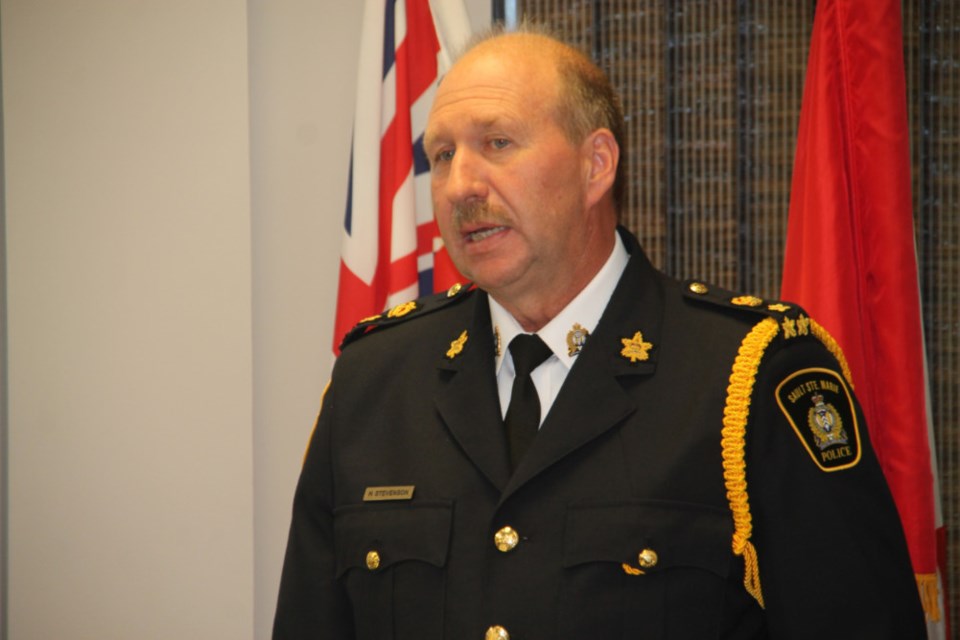Sault Ste. Marie has one less outlaw biker to worry about, due to stepped-up local law enforcement efforts.
At least, that's what we're hearing from Dr. Hugh Stevenson, the bushplane-flying, organized crime expert who took over in June as the city's new chief of police.
Stevenson says his drug officers have teased out details of the biker's departure from "credible, reliable informants."
"One of the local biker associates chose to leave town because he knew that the heat was going to be on him. He knew he couldn't conduct his business like he had done before," the new chief said at last week's meeting of City Council.
"That, to me folks, is success," he added.
Chief Stevenson has more than three decades of policing experience and an equally impressive record teaching law and justice courses to college and university students.
He's former director of the Ontario Provincial Police Academy in Orillia and former boss of Criminal Intelligence Services Ontario – a partnership between the Ontario government and law enforcement groups focused on taking down organized crime.
Away from police headquarters, Stevenson is a floatplane-certified pilot with a doctorate of education in clinical psychology and teaching.
'Catch and release' justice
Dr. Stevenson was also talking with surprising candour and chagrin about a downtown cruiser-ramming incident earlier this month.
"I wasn't going to tell you this, but I'm going to anyway," he told city councillors.
"The [Dennis Street incident] was one of the most challenging issues for this community."
"Six of my officers were injured. Three cruisers were damaged, with one gentleman accused that was on three or four releases. Yes, it does cause me frustration. It causes our membership frustration."
Stevenson was referring to our so-called 'catch and release' justice system, which allows people accused of serious crimes to be released from pre-trial detention, often returning to the streets within hours.
"The problem is, they're back out by three o'clock. The question is, where is the downside to being a criminal, if you know you can do it and get back out?"
"What really hit home for me was when our six officers ended up injured when that individual could have been kept in custody."
"People can point the finger at the chief of police and say: 'You're the guy releasing them.' We are holding people for bail as we are supposed to. It's a stepped process in bail release....I'm very supportive of human rights. But I'm also concerned about our community."
"We are well-funded and well-staffed, but we can only bring them to the courthouse. Right now, what we're finding, it's a cycle. We'll bring them in, and I can tell you they know by three o'clock they're released."
"You'll notice I've never used the word 'blame.' I've never identified one agency. This is a collective that we have to look at and examine together," Chief Stevenson said.
"Multiple criminal justice partners have to work together to ensure community safety."
Downtown crime sweep
The new police chief provided Mayor Provenzano and city councillors with a verbal update on his first three months on the job.
His initial focus has been on downtown Sault Ste. Marie, where merchant complaints about criminal activity had previously fallen on deaf ears.
"I was in place for approximately two weeks when I realized, both through some of your input from around this table, from community input and my own officers, that we needed to change our focus in the downtown core. We had to get back to a more pro-active and more intelligence-led traditionalist approach," he said.
On July 2, Stevenson deployed a special High Enforcement Action Team (HEAT).
"We had 15 officers that were more or less doing double duty – their own job as well as a 3-to-3 shift in the downtown core."
"This involved uniformed patrol. It involved what we would call 'old-clothes' [hobo-cop] assignments. It involved good old developing of informants. It involved finding out who's selling drugs in our community. It involved seizing those drugs, contraband, guns. It involved dealing with the prostitution issues."
Here's what the HEAT team accomplished within five weeks:
- 75 arrests
- 52 provincial charges
- 136 Criminal Code charges
- 35 outstanding warrants
- three search warrants
- 1,927 methamphetamine tabs seized
- 39 grams of fentanyl
- 34 grams of crystal meth
- 21 grams heroin
- 123 grams cocaine
- 15 grams weed
- five grams psilocybin
- firearms and other weapons seized
One traffic stop resulted in the seizure of $3,500 of illicit drugs and the two individuals charged are being investigated for possible involvement in break-ins, thefts from automobiles and thefts of firearms, the chief said.
A search warrant executed on a building took $10,000 in illicit drugs off the street.
Typically, about 100 individuals are arrested in Sault Ste. Marie each month.
In July, that number climbed to 154 as a result of the HEAT initiative.
Initially set for eight weeks, the enforcement blitz was extended for another four weeks until the end of September.
"My job is to keep this community safe. There's a variety of ways of doing it. One of them is letting the bad guys know that the police have changed their attitudes and approach in this community. We are prepared to put people in jail."
"There were many of these folks who were in the organized crime spectrum... They chose to change their behaviours in the city as a result of this."
In October, a Community Oriented Response and Enforcement Team will take over, with two officers responding to areas of concern throughout the city.
Despite the significant increase in charges, break and enters continue to rise, doubled from last year, Stevenson said.
"These are the same people that we're arresting that are going out and doing your B and Es."
